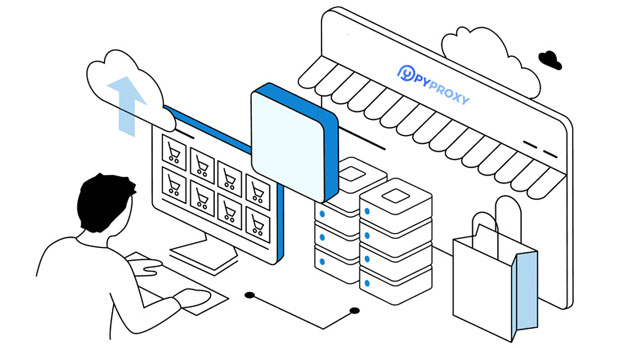In the world of online privacy and security, proxy services play a critical role. Among the many options available in the market, PYPROXY and ProxyProxy are two prominent providers that are often compared based on their pricing and service cost-effectiveness. When choosing between these two, customers must consider factors such as subscription costs, the quality of the service provided, the number of available features, and customer support. This analysis will break down the key aspects of both services, highlighting their strengths and potential shortcomings to help users make an informed decision. 1. Overview of PyProxy and ProxyProxyBoth PyProxy and ProxyProxy are highly regarded services in the proxy industry. Each provides a range of solutions tailored to users who need secure internet browsing, whether for personal use or business needs. While their core service—providing users with anonymity and access to geo-blocked content—is similar, there are several factors that set them apart in terms of pricing, reliability, and added value.2. Pricing Structure ComparisonPyProxy Pricing PyProxy offers multiple pricing tiers that cater to different user needs. The service typically charges on a subscription basis, with various packages depending on the number of proxies needed, bandwidth, and the level of support. The pricing starts from a basic plan with limited proxy access, going up to premium plans that offer high-speed connections, unlimited bandwidth, and additional features such as IP rotation and private proxies. PyProxy’s pricing is generally considered affordable, especially for users who only require limited services. However, higher-tier plans can be relatively costly compared to some other providers in the market.ProxyProxy Pricing ProxyProxy also follows a subscription model with several tiers, but it differs in its offering of flexible packages. ProxyProxy provides more scalability in terms of service, allowing users to adjust their plan based on changing requirements. The pricing is slightly higher than PyProxy's for entry-level plans but offers more features, such as specialized proxies for specific use cases like web scraping, social media management, and SEO tools. ProxyProxy offers a tiered payment plan with pay-as-you-go options for users who do not need long-term commitments. This makes ProxyProxy a more flexible option for users who need custom proxy configurations.3. Service Features and FunctionalityPyProxy Service Features One of the biggest selling points of PyProxy is its user-friendly interface and simple setup process. The service is designed for users who want quick and efficient proxy access without the need for complicated configurations. Key features of PyProxy include high-level encryption, unlimited bandwidth on premium plans, and reliable customer support. The service also allows users to select proxies from a wide range of countries, making it ideal for accessing geo-restricted content. However, PyProxy may lack some of the more advanced features that other services, like ProxyProxy, offer, such as automated IP rotation or specialized proxies for specific tasks.ProxyProxy Service Features ProxyProxy stands out for offering a more comprehensive set of features tailored to businesses and advanced users. Some notable features include automated IP rotation, dedicated proxy pools, and the ability to create custom proxy solutions based on specific needs, such as data scraping or social media marketing. The service also provides advanced security options and a higher level of anonymity, which makes it suitable for users who need more robust privacy protection. ProxyProxy's proxy pool is larger, and its features are more flexible in comparison to PyProxy's offerings, making it a better choice for users with complex requirements.4. Speed and ReliabilityPyProxy Speed and Reliability PyProxy generally offers good speeds for basic browsing, streaming, and light online activities. However, when it comes to heavy tasks like data scraping or high-volume content streaming, users may experience slower speeds, especially on lower-tier plans. The service does provide fast connection options on its premium plans, but speed can still vary depending on server load and geographical location. While reliability is typically high for standard tasks, performance can fluctuate under more demanding use cases.ProxyProxy Speed and Reliability ProxyProxy’s infrastructure is designed for high-performance tasks, making it the go-to choice for users who need consistent and fast speeds. With premium options that offer high-bandwidth proxies and specialized servers, ProxyProxy’s speed is generally more reliable, especially for high-demand activities like data collection, SEO, and web scraping. Additionally, the service's larger pool of proxies and automated IP rotation feature help ensure that users have continuous access to fast and reliable connections, even during peak usage times.5. Customer Support and User ExperiencePyProxy Customer Support PyProxy offers standard customer support with 24/7 assistance through live chat and email. While the support team is responsive, some users have reported that the quality of the support varies, especially during peak hours. There are also some limitations in the self-help documentation and knowledge base, which could make troubleshooting more challenging for users without technical expertise. However, for users with basic needs, PyProxy’s customer support is generally sufficient.ProxyProxy Customer Support ProxyProxy excels in customer service, offering a robust support system that includes live chat, email, and phone support for enterprise-level clients. The service is known for its dedicated account managers, which is particularly beneficial for businesses with complex requirements. Additionally, ProxyProxy provides a comprehensive knowledge base with detailed tutorials, FAQs, and troubleshooting guides, making it easier for users to resolve issues independently. The overall user experience is superior due to the attention to customer satisfaction and the range of resources available.6. Cost-Effectiveness and Value for MoneyPyProxy Cost-Effectiveness PyProxy is a solid choice for users looking for a simple, budget-friendly proxy service. While it may not offer the advanced features found in some other services, its pricing structure provides good value for customers who need basic proxy functionality. The service’s lower-tier plans are particularly appealing to individuals or small businesses that do not require advanced security or performance features but still want a reliable proxy solution.ProxyProxy Cost-Effectiveness Although ProxyProxy’s pricing is generally higher than PyProxy’s, the value it offers is significant for users who need more advanced features and higher reliability. The flexibility in pricing, combined with a wider range of features and better customer support, makes ProxyProxy a more cost-effective solution for businesses or individuals with complex proxy needs. Users who require specialized proxies for tasks like SEO, data scraping, or social media marketing may find ProxyProxy to be worth the extra cost.Conclusion: Which is More Cost-Effective?When comparing the pricing and service cost-effectiveness of PyProxy and ProxyProxy, it is clear that both have their strengths. For users with basic needs, PyProxy provides an affordable and reliable service. However, those who require advanced features, more customization, and faster speeds should consider ProxyProxy, as it offers more flexibility and higher reliability at a slightly higher price point. Ultimately, the choice between these two services depends on the user's specific requirements and budget, with both providing valuable options in the world of online privacy and security.
Sep 02, 2025



































































